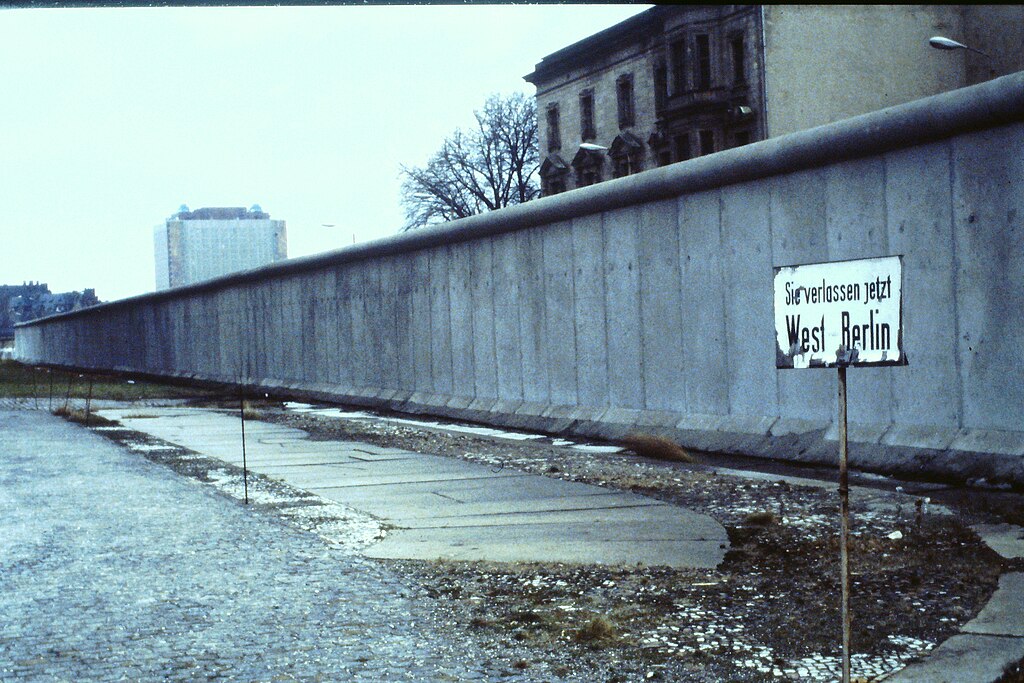Berlin has always been a city of paradoxes and contrasts, and nowhere is more poignant in that regard than the various sites of the Berlin Wall.
Note that capital letter. For nearly three decades, it wasn’t just any wall, nor simply a wall—it was The Wall, a barrier so singular and significant that it seemed to be the very first, the primordial wall, the one that stood above all others, needing no further introduction. The sites of that once formidable barrier are nearly all gone today but the memory and the ghosts remain. Yet to tap into the essences of those spectral memories is not quite so easy as it might seem. Let’s take a quick look at how you might approach the various wall memorials, and the memories they evoke, to savor and reflect on those contradictions and ironies that make Berlin the city it is.

The Wall Memorial at Bernauer Strasse: A Contrast of Then and Now
Whenever I happen to visit the official Wall memorial at Bernaurstrasse, I’m struck by how timid it looks in it reconstructed retirement. It’s not particularly high or fearsome in appearance. I’ve seen used car lots better guarded, or so it feels today looking at the feeble remains. And this brings us to our most obvious contrast, that between then and now. Today, the site feels easy and relaxed. You’ll hear kids laughing, tourists reading information signs and locals out for summer strolls in the warm bright sun, heading perhaps for a picnic or game of football.
What’s missing today is the atmosphere of the Wall as it was then, the feeling of oppression and division that it provoked. Where today kids play and people enjoy their free time, was then scarcely populated. On the Eastern side of the Wall, of course, nobody ventured near the barrier apart from the guards. Even on the far side of the inner wall, you had to have a residence permit or some solid demonstrable reason to be within a block or two of the «zone» as it was sometimes called. Anybody who didn’t risked arrest. On the Western side, tourists and occasionally locals would come to gawk at the concrete barrier and perhaps scrawl some graffiti on it, but otherwise it’d be hard to say it was visited by anybody who was not brand new to the city. Today, life and laughter abound where there was once mere desolation and iron-clad security.
The Color of Today vs. the Grey of the Past
The next thing today’s visitor might notice is the colour. In our imagination, the time of the Wall was black and white, characterized by grainy images, by snow, by coldness and an overriding grey. Even in those full colour 1980s snapshots, taken in the height of summer, there remains a lurking sense of greyness and heaviness about the images. Today’s mobile phone photos are full of greens and red and blues. Colour, vibrant and alive, abounds. The contrast between two images taken today and forty years ago in the same spot is jarring, and in some unearthly way, fascinating.

The Deeper Contrasts: Power, Fear, and Weakness
Then we get to the deeper contrasts and contradictions. What strikes the reader about the Wall is the power it was meant to project. At its height, the Wall was likely the world’s most advanced and carefully designed defensive structure, the most heavily guarded border, equipped with the latest technology. Power and a hulking permanence were etched on its grey concrete features. Yet that jarring projection of authority tried to disguise weakness and weakness’s byproduct, fear.
When built, the Wall was officially designed by the East as the Anto-Fascist Protection Barrier. We might be tempted to laugh at this with knowing cynicism, but we’d be missing something vital about the Wall. It was, at least partly, built to protect the population of the communist DDR from the reinvigorated evils of western capitalist fascism. This sounds absurd to any of us raised far way from the DDR or on the other side of the wall, but to the Communist leadership of the early 1960s, the west was guilty of rehabilitating former Nazis and dressing them up as capitalist businessmen and government agents, and sending them into the East, to weaken and destroy communism from within. To be fair to the DDR’s leadership, this fear was not entirely unfounded, as the west did indeed recruit former Nazis after a sometimes very superficial «de-Nazification» process and sending them east in various capacities.
Of course, the immediate impetus behind the building of the Wall was the dramatic outflow of DDR citizens to the west. These people could, before the Wall was built, exit without too much fuss. Fewer and fewer of those who left came back, and the numbers leaving was increasing dramatically in 1960 and into 1961. The Wall was built when it was to stop the new nation from bleeding to death and collapsing before the dream of communism could be attained.
The Wall’s Legacy: Fear and Relief
When you visit the remains of the Wall, bear in mind not just the local fears but also international ones that played an enormous role in the construction of the Wall. Berlin was, as many commented at the time, one of the most dangerous places in the world in the 1950s and early 1960s, the place where many thought WW3 and nuclear annihilation would be triggered as spies flowed back and forth, international incidents took place and arguments constantly arose as one side and the other jostled for control of the city during those increasingly tense years of the Cold War. The Wall, in practical effect, froze the conflict and made a sudden lightening strike across the volatile border that much less likely. After all, if you build a wall, you’re hardly likely to invade across it the next day. For all the rhetorical ammunition the building of the Wall supplied to Western orators, the Wall in fact let everybody breath a sigh of relief.
So look at the Wall’s remains today and consider that this border, once the most formidable in the world, was driven and sustained by fear. Fear that the West would bring down the East, anxiety that the East was bleeding to death via loss of its fleeing citizens and terror of nuclear Armageddon. The Wall, once a looming grey presence and a stark reminder of how fear can push us to the brink, now bursts with color and laughter. This transformation isn’t the letdown some visitors believe it to be, but rather a celebration—a triumph of reason, and of life itself.
Yet another one of those Berlin lessons that stick with you long after you get back home




